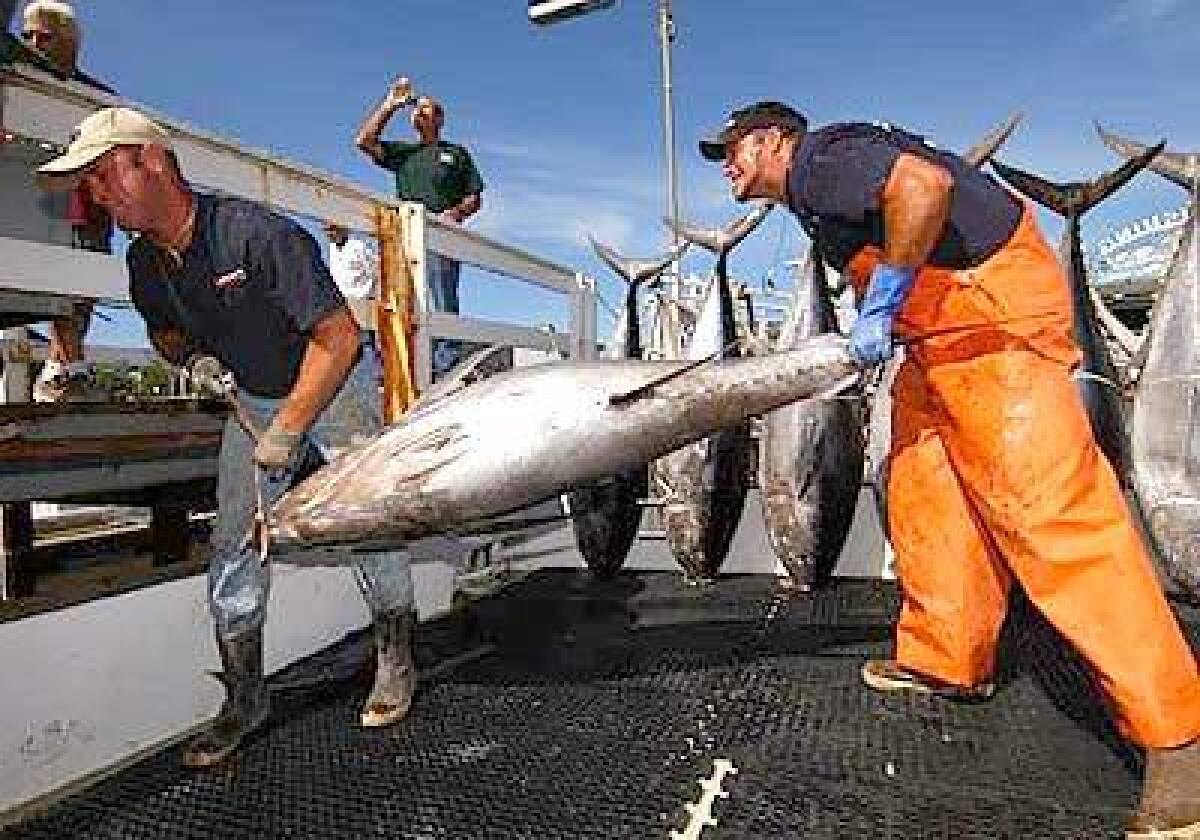Anglers hammer giant tuna

It’s a joyous circus when the Royal Polaris returns to San Diego Harbor after 22 days at sea loaded with yellowfin tuna. Fish tied tails-up to the stern are arrayed like a turkey’s fan tail, their curved second dorsal and pectoral fins glint translucent yellow in morning light.
Fifteen tuna exceed 200 pounds, a trophy-class fish. In an extraordinary season, San Diego-based long-range boats, making runs hundreds of miles to waters off the Mexico coast, have averaged a dozen such yellowfin per trip. The Excel returned to Point Loma with a record 41 big ones in December.
FOR THE RECORD:
Tuna fishing —An article in Tuesday’s Outdoors section about tuna fishing referred to an angler as Rusty Johnson. His name is Frosty Johnson. The article also said Jack Nilsen caught a 248-pound fish using a tuna-catching device called a kite; Nilsen did not catch the fish using a kite. In addition, Gayle Johnson was quoted as saying, “Fish hard, lick the bait, and don’t think you know more than the crew.” In fact, she said, “Fish hard, pick the bait, and don’t think you know more than the crew.”
“It’s been the best season for big fish in the history of San Diego sportfishing,” says Bob Fletcher, president of the Sportfishing Assn. of California, which monitors the long-haul boats. “Last year was good. This year has been even better.”
Skippers credit abundant bait such as mackerel and jacks, better tackle, fewer sharks, and warmer water at higher latitudes for pushing fish farther north from their normal haunts near the equator.
Favored destinations for this year’s catch include the Clipperton atoll, 550 miles west of Acapulco, and Hurricane Bank off Cabo San Lucas.
At the dock, seals greet the Royal Polaris first, bobbing in the gently frothing wake like expectant dogs. A wife calls to her man, and the crewmates’ mates gathered at the dock greet husbands and boyfriends with sexy, fun yelps. Men rush down a gangway slippery from rain the previous night of March 4 to unload tuna. The smell of fish, diesel and salt is bracing.
The boat yields so many fish it looks like anglers emptied the ocean. Crews pile chilled wahoo (called ono, “delicious,” in Hawaii) on the deck like cordwood, and scatter smaller tuna everywhere. They hoist the yellowfin with gaffs and ropes, and drop them into wooden carts for weigh-in.
One angler says hooking a giant tuna is a heart-pounding rush, a wrestling match, as much adrenaline as finesse. One second, “your bait is free-swimming, [then] all of a sudden the yellowfin grabs it, you drop the tip of your rod and throw the reel in gear, and launch into a headlong battle,” says Brian Buddell, an Oakland attorney aboard the Royal Polaris.
The world record for yellowfin stands at 388 pounds, but catching a 200-pounder enshrines an angler in the pantheon of this cultish sport that celebrates camaraderie and communing with the open sea.
A trip to Clipperton atoll costs $5,000, not counting tips and possible airfare. Not everyone takes the boat ride to get there; anglers can also fly to Puerto Vallarta to join the crew as it gathers rainbow runners, caballito and mackerel for bait. On the return, many customers step off at Cabo San Lucas, then fly home, though they can ride the boat back to San Diego. The 113-foot-long Royal Polaris holds 20 small, 8-feet by 10-feet cabins, and a crew of six and two chefs. On the 60-hour chug toward Clipperton from Puerto Vallarta, the crew conducts fishing seminars, serves big meals and plays DVDs.
The fishing occurs from three miles offshore to within 150 feet of the atoll. Anglers awaken at 3 a.m. for the early bite. The crew relies on sonar and experience to track yellowfin. They try to get the hooked fish to the transom before sharks — mostly silkies, Galapagos and an occasional hammerhead — strike. Sharks fight “like wet bags of cement,” says Allison Shuman, a cardiac nurse, though dolphins steal bait without getting hooked.
Gayle Johnson who met her husband, Rusty, on a long-haul trip, feeds baitfish like pets, and uses the boat’s rail to gain leverage for the rod while fighting a tuna. “Fish hard, lick the bait, and don’t think you know more than the crew,” she counsels.
This is her third long-haul trip and her first fish over 200 pounds (211 pounds, 2 ounces) “When they stuck her fish, I actually had tears in my eyes, I was so happy for her,” says Rusty, facilities manager at Loyola Marymount University.
“Getting on the atoll was the most awesome moment for me,” says Suzie Langdale, a dental hygienist from San Clemente, who caught the first big tuna of the trip. “It’s all coral, no trees, reef fish everywhere, surrounding a brackish pool that Jacques Cousteau once tried to dive. He was driven back by sulfuric acid” in the water, she says.
Each day, the anglers donated caught sharks to French researchers on the island, one of the few atolls with no opening to the sea, says Royal Polaris captain and co-owner Frank Lo Preste.
Shouts go up from the scales behind us. The biggest yellowfin tips 248 pounds. Jack Nilsen, founder of Corona-based Accurate Fishing Products, caught it. His reel, fashioned from a block of aircraft-grade aluminum, costs $1,400. He caught the fish “on the kite,” which means his line was looped to a special kite flying above the boat so the sardine looks natural to tuna.
Beaming like Hemingway on a good day, Nilsen credits his catch to “blind luck, good equipment and maybe some skill somewhere.”
Once he hooked into the big one, Nilsen and a crew member boarded a 12-foot skiff to avoid tangling other anglers’ lines and set out to fight the tuna.
“The fish pulled me around for 45 minutes,” old-man-in-the-sea style, Nilsen says. They finally tied the fish to the skiff and motored back to the Polaris.
“Lots of sharks on some days,” smiles Nilsen. “If they hit that fish, it would be all over, for the fish. I don’t think it would be a safety issue for us. But we all made it.”
More to Read
Sign up for The Wild
We’ll help you find the best places to hike, bike and run, as well as the perfect silent spots for meditation and yoga.
You may occasionally receive promotional content from the Los Angeles Times.






